Duck typing in Scala
Scala keeps surprising me. It has much good stuff that F# has. For example, I believed that statically resolved type parameters are unique to F#. Turns out this is not the case. Scala has equivalent feature called "structural types". It has nice syntax compared to F#'s statically resolved type parameters. However, it uses reflection under the hood while F# uses inlining to instantiate functions in-place at compile time. This approach should definitely have awful performance characteristics. Surprisingly, it's not the case:
Static call took about 0.5 seconds, "duck typing" call took about 4 seconds. It only 8-10 times slower than static call. Frankly, I expected something like 100x - 1000x degradation. So, it's not as fast as the equivalent feature in F#, but it certainly practically useful in many circumstances.



Comments